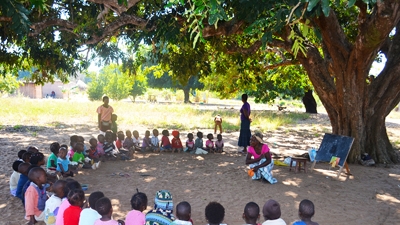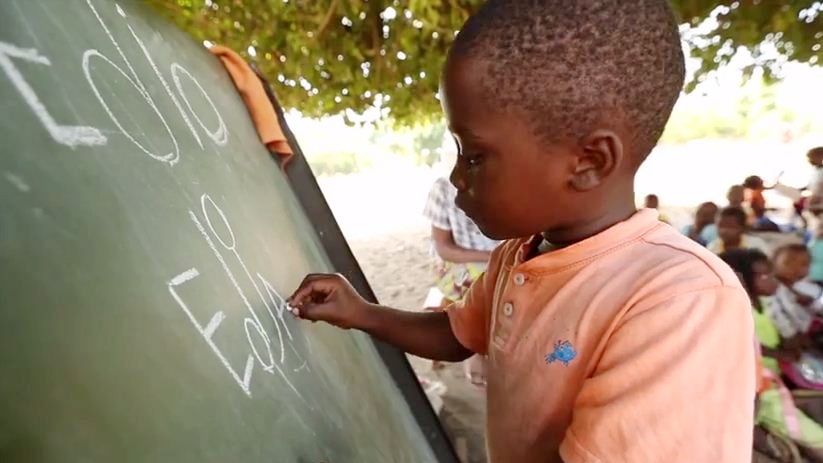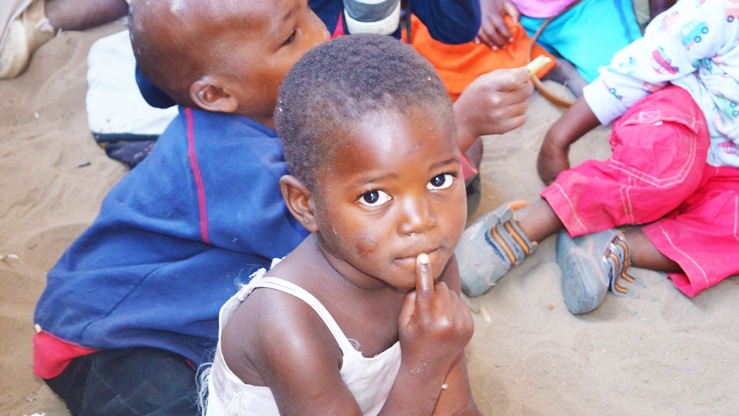Gaza Province, Mozambique -- Under the shade of a spreading mafura tree, preschool teacher Carmelina Alberto Makuite places three bottlecaps in the sand and asks her class of 30 to count. “Um! Dois ! Três!,” her 3- to 5-year-old students shout, showing off not only budding mathematics skills but newly acquired Portuguese – the language of instruction in Mozambique and a change from the Changana dialect spoken at home.
The morning’s lesson has preschoolers in remote Mahuntsane village—a 4-hour drive northeast of the capital Maputo – learning numbers, days of the week, and body parts, as well as answering questions after the teacher reads a Portuguese story about a spider and a dog. The skills the children learn here – cognitive, linguistic, socio-emotional and physical – are critical for long-term healthy development and will give them a strong start when they reach first grade.
“Primary school teachers are very happy with the children coming from the escholinha [preschool],” says Makuite, who has taught at the preschool since 2008. “The children know the alphabet and can write their names. They follow the teacher’s instructions. They are leaders in the class.”

Scaling Up Across Five Provinces
Mahuntsane’s preschool is part of a pilot program, begun in 2008, to strengthen early childhood development in 30 villages in rural Gaza Province. Led by the nongovernmental organization Save the Children, the program’s success—demonstrated by a rigorous impact evaluation -- attracted support from the Ministry of Education, which is now scaling up the initiative across 600 communities in five provinces, to reach 84,000 young children with services to stimulate their growth and development. The World Bank’s Fund for the Poorest (IDA) is providing support for the scale-up through a $40 million education policy loan, which also finances capacity and knowledge building activities for government agencies and key stakeholders to ensure sustainability.
“The government felt it important to invest in early childhood education because our children, in first grade, have great difficulty in reading and writing. This led us to devise a national strategy involving various ministries, such as social affairs, health, food security and nutrition,” said Ines Tembe Magode, Chief of Preschools in the Ministry of Education. “This whole movement was a kind of awakening for our government.”
The government kicked off the scale-up project earlier this year, and participating communities have already been identified, she added. “We’re now working to sensitize parents and caretakers so they’re aware of the importance of taking their children to preschools.”
Importance of Investing Early
Early gaps in cognitive skills and overall development can jeopardize a child’s capacity and motivation to learn upon entering primary school, says Sophie Naudeau, a World Bank Senior Education Specialist based in Maputo, who co-led the impact evaluation of the pilot program and manages the new IDA loan. “Low levels of school readiness can lead to inefficiencies in the education system. Children lacking early support are more likely to have poor academic performance, repeat grades, and drop out of school before they complete the primary cycle,” she says.
To bridge these kinds of gaps, between 2001 and 2013, the Bank invested more than US$3.3 billion (US$1.9 billion supporting the poorest countries through IDA) in early childhood development activities worldwide, including education, health, and social protection activities, which target pregnant women, young children, and their families.
Early childhood development features prominently within the Bank’s Education Strategy 2020, which sets the goal of Learning for All through three pillars: Invest Early, Invest Smartly, Invest for All. It is also a strong component of the Bank’s health and nutrition, and social protection strategies.


